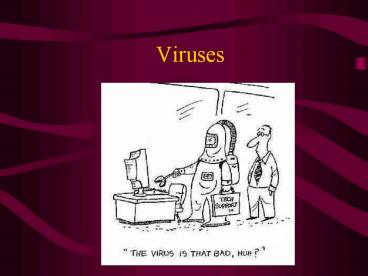Viruses - PowerPoint PPT Presentation
1 / 13
Title: Viruses
1
Viruses
2
VIRUSES General Information
- Non Living
- Contains a Caspid Protein coat surrounding it.
- Core is composed of either DNA or RNA.
3
(No Transcript)
4
DNA VIRUSES
- Contains either single strand or double strand
of DNA - Virus inserts the viral DNA into host cell.
- Occurs in the nucleus.
5
VIRAL DNA REPLICATION
- Cell Divides and viral DNA is replicated.
- Viral DNA is produced every time the cell
divides
6
VIRAL DNA REPLICATION
- Viral mRNA leaves the nucleus
- Attaches to Ribosome's
- Viral proteins are produced.
7
RNA VIRUSES
- Examples Polio and Tobacco Mosaic Viruses.
- Viral RNA enters the cell and travels directly
to the ribosome. - Makes viral proteins.
8
RETROVIRUS
- Enters the cell as RNA
- Travels to the nucleus
- Converts viral RNA to viral DNA
- Uses Reverse Transcriptase
- Viral DNA inserts itself into the actual
chromosomes of the host organism. (Provirus)
9
RETROVIRUS (backwards virus / HIV)
- The viral DNA is then replicated with the normal
DNA - The cell now produces viral RNA to and makes
viral proteins.
10
RETROVIRUS
- Example HIV
- HIV replicates very quickly
- Takes over the cell
- Mutates rapidly
- Difficult to make a vaccine.
11
Lytic Cycle
1. Attachment Virus attaches to host cell
2. Entry Nucleic Acid is injected into the cell
5. Lysis and Release Host cell breaks open and
new viruse are released.
3. Replication Viral DNA is replicated
4. Assembly New virus particles are assembled
12
Lysogenic Cycle
- Viral DNA becomes a part of the host cells
chromosomes (provirus) - The virus is inactive but still replicates with
the normal DNA. - Continues to replicated until it decides to enter
the Lytic Cycle. - The virus will leave the host chromosomes and
then undergoes Lytic Cycle.
13
Comparison of Lytic and Lysogenic Cycles of
Viruses































